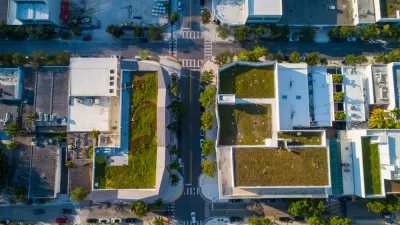New green buildings may be de riguer, but preservation does less harm.

In the last 50 years, humans have used more raw materials and created more waste than in all previous history,” report Jean Carroon FAIA and Ben Carlson.
By now, recycling and reuse are firmly rooted concepts in the American consumer conscience. But when it comes to building, the merits of maintaining and preserving existing buildings are often trumped by the short-term cost efficiencies of replacement and the rewards of green certification.
The built environment is the single largest consumer of materials, which account for 42 percent of all greenhouse gasses emitted in the United States. "Every product, no matter how green, has environmental impacts that include carbon emissions, water and energy consumption, pollution, toxicity, and waste," write Carroon and Carlson. Toxicity from building materials, such as the flame retardants used on everything from carpets to cables, impacts all Americans. "These chemicals are linked to dna mutation, thyroid disruption, memory and learning problems, delayed mental and physical development, lower IQ, advanced puberty, and reduced fertility."
Another critical concern often overlooked is the immediate impact of greenhouse gases emitted from building material extraction, production, construction, and disposal in favor of the touted energy efficiencies of new green buildings. But these energy savings are long-term projections, according to Careen and Carlson, pointing to a 2012 report for the National Trust for Historic Preservation. "It can take between 10 and 80 years for even an energy-efficient new building to overcome, through cleaner operations, the climate change impacts created by its construction." Carroon and Carlson argue that even if we do eventually achieve the goal of manufacturing totally clean and green buildings, there is inherent value in preservation. "Doesn’t a sustainable world need to value what already exists not only for environmental reasons but also to foster creativity, social engagement, and a unique sense of place?"
FULL STORY: Old is the new green

Maui's Vacation Rental Debate Turns Ugly
Verbal attacks, misinformation campaigns and fistfights plague a high-stakes debate to convert thousands of vacation rentals into long-term housing.

Planetizen Federal Action Tracker
A weekly monitor of how Trump’s orders and actions are impacting planners and planning in America.

Chicago’s Ghost Rails
Just beneath the surface of the modern city lie the remnants of its expansive early 20th-century streetcar system.

Bend, Oregon Zoning Reforms Prioritize Small-Scale Housing
The city altered its zoning code to allow multi-family housing and eliminated parking mandates citywide.

Amtrak Cutting Jobs, Funding to High-Speed Rail
The agency plans to cut 10 percent of its workforce and has confirmed it will not fund new high-speed rail projects.

LA Denies Basic Services to Unhoused Residents
The city has repeatedly failed to respond to requests for trash pickup at encampment sites, and eliminated a program that provided mobile showers and toilets.
Urban Design for Planners 1: Software Tools
This six-course series explores essential urban design concepts using open source software and equips planners with the tools they need to participate fully in the urban design process.
Planning for Universal Design
Learn the tools for implementing Universal Design in planning regulations.
planning NEXT
Appalachian Highlands Housing Partners
Mpact (founded as Rail~Volution)
City of Camden Redevelopment Agency
City of Astoria
City of Portland
City of Laramie




























